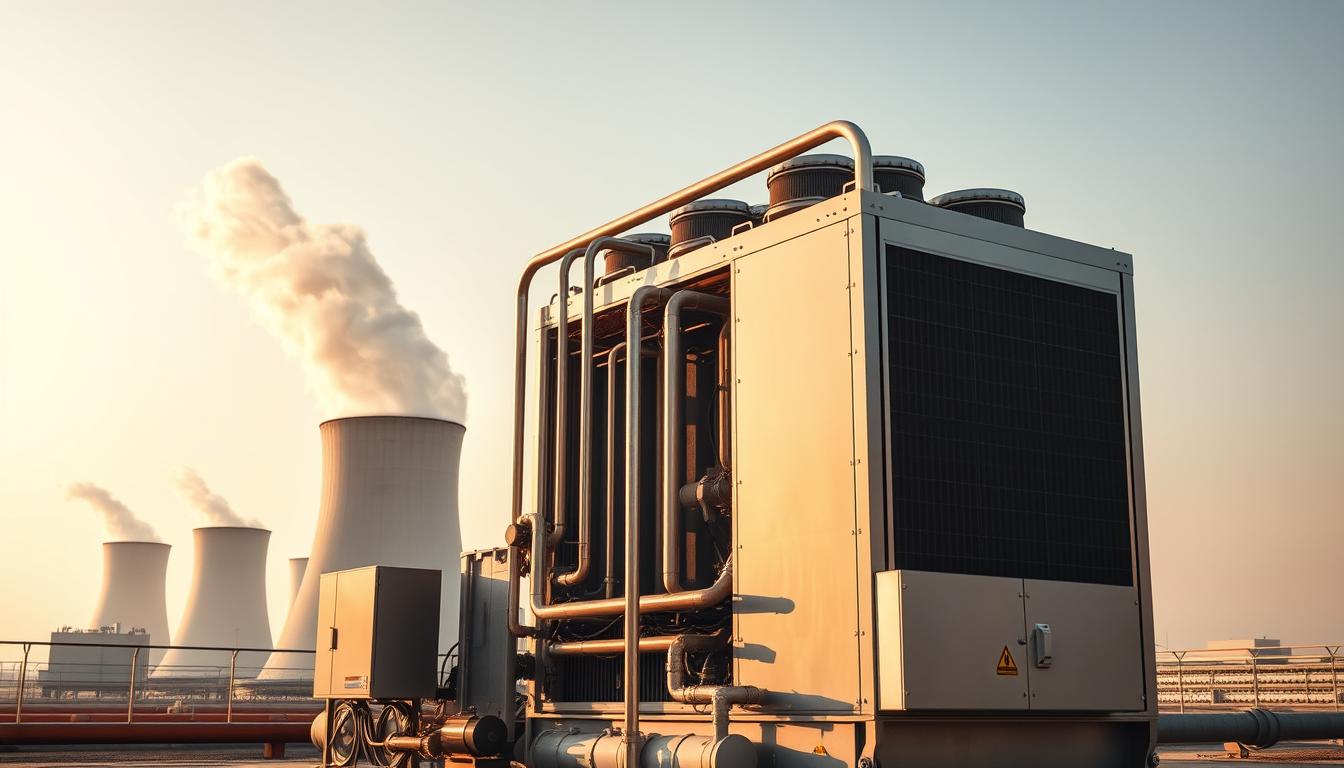In today’s commercial buildings, keeping the indoor climate just right is key. HVAC water chillers and cooling towers are vital for this. Water chillers cool the water that flows through HVAC systems. Cooling towers help get rid of heat from the refrigerant process.
Together, they boost energy efficiency and are the heart of climate control systems. This ensures comfort in big facilities. Let’s dive deeper into how these parts work and why they’re so important in commercial HVAC solutions.
Understanding the Basics of HVAC Water Chillers:
I’ve learned about different types of HVAC water chillers. These include air-cooled, water-cooled, and absorption chillers. Each type has its own role in cooling, helping to keep temperatures right in various places. For example, air-cooled chillers use air to cool the refrigerant, while water-cooled ones use water for better cooling.
These chillers work by moving heat through vaporization and condensation. They cool a liquid, then send it back to cool more. This keeps the temperature just right in a space.
When we talk about how well a chiller works, we look at its efficiency ratings. SEER and EER show how much energy a chiller uses. This helps us choose the best chiller for our needs.
The parts of a chiller, like evaporators, compressors, and condensers, are key to its cooling power. The evaporator takes in heat, the compressor raises the refrigerant’s pressure, and the condenser transfers the heat. Knowing about these parts is important for anyone working with HVAC systems.
The Importance of Cooling Towers in HVAC Systems:
Cooling towers are key in HVAC systems. They help with evaporative cooling, which is vital for cooling down. Without them, HVAC systems wouldn’t work as well.
There are many types of cooling towers, like open, closed, and hybrid systems. Each one helps with cooling in its own way. Open towers use outside air, while closed and hybrid ones save water and keep systems clean.
Knowing how cooling towers work with water chillers helps us see their value. Together, they make HVAC systems more efficient. This leads to lower costs and better energy use.
Benefits of Integrating HVAC Water Chillers and Cooling Towers:
Combining HVAC water chillers with cooling towers boosts system performance. This team-up makes cooling more efficient. It cuts down energy use, saving businesses a lot of money.
Today, we focus on green solutions in HVAC. Water chillers and cooling towers help reduce carbon emissions. They make sure resources are used wisely. Many companies have seen their costs drop after switching to these systems.
Maintenance Practices for HVAC Water Chillers and Cooling Towers:
Keeping HVAC systems in top shape is key to their long life and efficiency. Regular checks and services are a must. I stress the need for water chiller upkeep, like checking fluid levels and refrigerant pressures. This ensures all parts work well.
Ignoring these steps can cause big problems. It can make systems less efficient and lead to expensive fixes.
Cooling tower care is just as important. I suggest a routine that includes cleaning the basin and checking for algae. Also, make sure fans work right. These steps boost performance and prevent breakdowns.
Watching temperature and pressure levels helps spot issues early. This way, problems don’t get worse.
With a solid maintenance plan, HVAC systems run better. Cleaning coils and filters regularly keeps efficiency high. Tackling these tasks quickly saves energy and extends system life.
Future Trends in HVAC Water Chillers and Cooling Tower Technologies:
Looking ahead, HVAC technology is changing fast. Energy-saving innovations are leading the way in water chillers and cooling towers. These systems now cool better and use less energy. This shift is making cooling solutions more eco-friendly.
Smart HVAC systems are becoming more common. They offer real-time monitoring and optimization. This means better efficiency and lower costs for businesses. Remote control of these systems will change how we manage climate.
Automation is also a big deal for HVAC systems. New tech allows them to adjust on their own. AI and machine learning will soon make climate control smarter and more energy-efficient. I’m excited to see how these advancements will improve our buildings.
